Bodybuilding
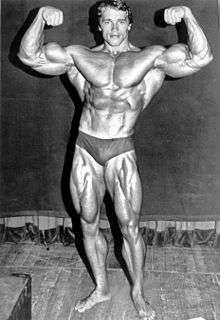
_-_Eugen_Sandow_(1867-1925).jpg)
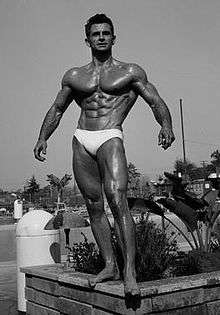
Bodybuilding is the use of progressive resistance exercise to control and develop one's musculature.[1] An individual who engages in this activity is referred to as a bodybuilder. In professional bodybuilding, bodybuilders appear in lineups and perform specified poses (and later individual posing routines) for a panel of judges who rank the competitors based on criteria such as symmetry, muscularity, and conditioning. Bodybuilders prepare for competitions through a combination of intentional dehydration, elimination of nonessential body fat, and carbohydrate loading to achieve maximum vascularity, as well as tanning to accentuate muscular definition. Bodybuilders may use anabolic steroids to build muscles.
The winner of the annual IFBB Mr. Olympia contest is generally recognized as the world's top male professional bodybuilder. The title was held by Phil Heath, who won every year from 2011 to 2017, but in 2018 the winner was Shawn Rhoden. The winner of the Women's Physique portion of the competition is widely regarded as the world's top female professional bodybuilder. The title is currently held by Juliana Malacarne, who has won every year since 2014. Since 1950, the NABBA Universe Championships have been considered the top amateur-bodybuilding contests, with notable winners such as Reg Park, Lee Priest, Steve Reeves, and Arnold Schwarzenegger.
Early history
Stone-lifting traditions were practiced in ancient Egypt, Greece and Tamilakam.[2] Western weightlifting developed in Europe from 1880 to 1953, with strongmen displaying feats of strength for the public and challenging each other. The focus was not on their physique, and they often had large bellies and fatty limbs.[3]
Eugen Sandow
Bodybuilding developed in the late 19th century, promoted in England by German Eugen Sandow, now called the "Father of Bodybuilding". He allowed audiences to enjoy viewing his physique in "muscle display performances". Although audiences were thrilled to see a well-developed physique, the men simply displayed their bodies as part of strength demonstrations or wrestling matches. Sandow had a stage show built around these displays through his manager, Florenz Ziegfeld. The Oscar-winning 1936 musical film The Great Ziegfeld depicts this beginning of modern bodybuilding, when Sandow began to display his body for carnivals.
Sandow was so successful at flexing and posing his physique that he later created several businesses around his fame, and was among the first to market products branded with his name. He was credited with inventing and selling the first exercise equipment for the masses: machined dumbbells, spring pulleys, and tension bands. Even his image was sold by the thousands in "cabinet cards" and other prints. Sandow was a perfect "Gracilian", a standard of ideal body proportions close to those of ancient Greek and Roman statues. Men were judged by how closely they matched these proportions.
First large-scale bodybuilding competition
Sandow organized the first bodybuilding contest on September 14, 1901, called the "Great Competition". It was held at the Royal Albert Hall in London. Judged by Sandow, Sir Charles Lawes, and Sir Arthur Conan Doyle, the contest was a great success and many bodybuilding enthusiasts were turned away due to the overwhelming amount of audience members.[4] The trophy presented to the winner was a gold statue of Sandow sculpted by Frederick Pomeroy. The winner was William L. Murray of Nottingham. The silver Sandow trophy was presented to second-place winner D. Cooper. The bronze Sandow trophy, now the most famous of all, was presented to third-place winner A.C. Smythe. In 1950, this same bronze trophy was presented to Steve Reeves for winning the inaugural NABBA Mr. Universe. It would not resurface again until 1977 when the winner of the IFBB Mr. Olympia contest, Frank Zane, was presented with the bronze trophy, or at least a replica of it. Since then, Mr. Olympia winners have been awarded a replica of the bronze trophy.
On January 16, 1904, the first large-scale bodybuilding competition in America took place at Madison Square Garden in New York City. The competition was promoted by Bernarr Macfadden, the father of physical culture and publisher of the original bodybuilding magazines such as Health & Strength. The winner was Al Treloar, who was declared "The Most Perfectly Developed Man in the World".[5] Treloar won a $1,000 cash prize, a substantial sum at that time. Two weeks later, Thomas Edison made a film of Treloar's posing routine. Edison had also made two films of Sandow a few years before. Those were the first three motion pictures featuring a bodybuilder. In the early 20th century, Macfadden and Charles Atlas continued to promote bodybuilding across the world. Alois P. Swoboda was an early pioneer in America.
Notable early bodybuilders
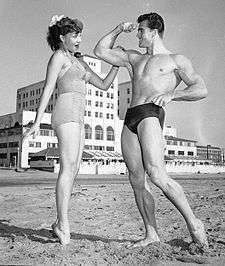
Many other important bodybuilders in the early history of bodybuilding prior to 1930 include Earle Liederman (writer of some of bodybuilding's earliest books), Zishe Breitbart, Georg Hackenschmidt, Emy Nkemena, George F. Jowett, Finn Hateral (a pioneer in the art of posing), Frank Saldo, Monte Saldo, William Bankier, Launceston Elliot, Sig Klein, Sgt. Alfred Moss, Joe Nordquist, Lionel Strongfort ("Strongfortism"),[6] Gustav Frištenský, Ralph Parcaut (a champion wrestler who also authored an early book on "physical culture"), and Alan P. Mead (who became an impressive muscle champion despite the fact that he lost a leg in World War I). Actor Francis X. Bushman, who was a disciple of Sandow, started his career as a bodybuilder and sculptor's model before beginning his famous silent movie career.
1950s–1960s
Bodybuilding became more popular in the 1950s and 1960s with the emergence of strength and gymnastics champions, and the simultaneous popularization of bodybuilding magazines, training principles, nutrition for bulking up and cutting down, the use of protein and other food supplements, and the opportunity to enter physique contests. The number of bodybuilding organizations grew, most notably the International Federation of Bodybuilders (IFBB), founded by Canadian brothers Joe and Ben Weider. Other bodybuilding organizations included the Amateur Athletic Union (AAU), National Amateur Bodybuilding Association (NABBA), and the World Bodybuilding Guild (WBBG). Consequently, the male-dominated contests grew both in number and in size. Besides the many "Mr. (insert town, city, state, or region)" championships, the most prestigious titles were Mr. America, Mr. World, Mr. Universe, Mr. Galaxy, and ultimately Mr. Olympia (which was started in 1965 by the IFBB and is now considered the most important bodybuilding competition in the world).
During the 1950s, the most famous competing bodybuilders were Bill Pearl, Reg Park, Leroy Colbert, and Clarence Ross. Certain bodybuilders rose to fame thanks to the relatively new medium of television, as well as movies. The most notable were Jack LaLanne, Steve Reeves, Reg Park, and Mickey Hargitay. While there were well-known gyms throughout the country during the 1950s (such as Vince's Gym in North Hollywood, California and Vic Tanny's chain gyms), there were still segments of the United States that had no "hardcore" bodybuilding gyms until the advent of Gold's Gym in the mid-1960s. Finally, the famed Muscle Beach in Santa Monica, California continued its popularity as the place to be for witnessing acrobatic acts, feats of strength, and the like. The 1960s grew more in TV and movie exposure, as bodybuilders were typecast in popular shows and movies.
1970s–1990s
New organizations
In the 1970s, bodybuilding had major publicity thanks to the appearance of Arnold Schwarzenegger, Franco Columbu, Lou Ferrigno, and others in the 1977 docudrama Pumping Iron. By this time, the IFBB dominated the competitive bodybuilding landscape and the Amateur Athletic Union (AAU) took a back seat. The National Physique Committee (NPC) was formed in 1981 by Jim Manion,[7] who had just stepped down as chairman of the AAU Physique Committee. The NPC has gone on to become the most successful bodybuilding organization in America and is the amateur division of the IFBB. The late 1980s and early 1990s saw the decline of AAU-sponsored bodybuilding contests. In 1999, the AAU voted to discontinue its bodybuilding events.
Anabolic/androgenic steroid use
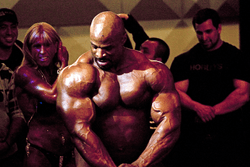
This period also saw the rise of anabolic steroids in bodybuilding and many other sports. In bodybuilding lore, this is partly attributed to the rise of "mass monsters", beginning with Arnold Schwarzenegger, Sergio Oliva, and Lou Ferrigno in the late 1960s and early 1970s, and continuing to the present day with Lee Haney, Dorian Yates, Ronnie Coleman, and Markus Rühl. Bodybuilders such as Greg Kovacs and Paul Demayo attained mass and size that were not seen previously but were not particularly successful at the pro level. At the time of shooting Pumping Iron, Schwarzenegger (while never admitting to steroid use until long after his retirement) said that "you have to do anything you can to get the advantage in competition". He would later say that he does not regret using anything.[8]
To combat steroid use and in the hopes of becoming a member of the IOC, the IFBB introduced doping tests for both steroids and other banned substances. Although doping tests occurred, the majority of professional bodybuilders still used anabolic steroids for competition. During the 1970s, the use of anabolic steroids was openly discussed, partly due to the fact they were legal.[9] In the Anabolic Steroid Control Act of 1990, U.S. Congress placed anabolic steroids into Schedule III of the Controlled Substances Act (CSA). In Canada, steroids are listed under Schedule IV of the Controlled Drugs and Substances Act, enacted by the federal Parliament in 1996.[10]
World Bodybuilding Federation
In 1990, professional wrestling promoter Vince McMahon announced that he was forming a new bodybuilding organization named the World Bodybuilding Federation (WBF). McMahon wanted to bring WWF-style showmanship and bigger prize money to the sport of bodybuilding. A number of IFBB stars were recruited but the roster was never very large and featured the same athletes competing; the most notable winner and first WBF champion was Gary Strydom. McMahon formally dissolved the WBF in July 1992. Reasons for this reportedly included lack of income from the pay-per-view broadcasts of the contests, slow sales of the WBF's magazine Bodybuilding Lifestyles (later WBF Magazine), and the expense of paying multiple six-figure contracts while producing two TV shows and a monthly magazine.
2000s
In 2003, Joe Weider sold Weider Publications to AMI, which owns the National Enquirer. The position of president of the IFBB was filled by Rafael Santonja following the death of Ben Weider in October 2008. In 2004, contest promoter Wayne DeMilia broke ranks with the IFBB and AMI took over the promotion of the Mr. Olympia contest. Other professional contests emerged in this period, such as the Arnold Classic, Night of Champions, and the European Grand Prix of Bodybuilding.
In the early 21st century, patterns of consumption and recreation similar to those of the United States became more widespread in Europe and especially in Eastern Europe following the collapse of the Soviet Union. This resulted in the emergence of whole new populations of bodybuilders emerged from former Eastern Bloc states.
Olympic sport discussion
In the early 2000s, the IFBB was attempting to make bodybuilding an Olympic sport. It obtained full IOC membership in 2000 and was attempting to get approved as a demonstration event at the Olympics, which would hopefully lead to it being added as a full contest. This did not happen and Olympic recognition for bodybuilding remains controversial since many argue that bodybuilding is not a sport.[11]
Areas
Professional bodybuilding
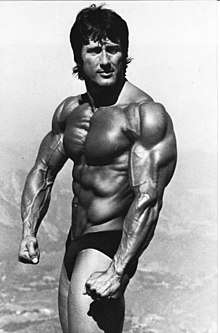
In the modern bodybuilding industry, the term "professional" generally means a bodybuilder who has won qualifying competitions as an amateur and has earned a "pro card" from their respective organization. Professionals earn the right to compete in competitions that include monetary prizes. A pro card also prohibits the athlete from competing in federations other than the one from which they have received the pro card.[12] Depending on the level of success, these bodybuilders may receive monetary compensation from sponsors, much like athletes in other sports.
Natural bodybuilding
Due to the growing concerns of the high cost, health consequences, and illegal nature of some steroids, many organizations have formed in response and have deemed themselves "natural" bodybuilding competitions. In addition to the concerns noted, many promoters of bodybuilding have sought to shed the "freakish" perception that the general public has of bodybuilding and have successfully introduced a more mainstream audience to the sport of bodybuilding by including competitors whose physiques appear much more attainable and realistic.
In natural contests, the testing protocol ranges among organizations from lie detectors to urinalysis. Penalties also range from organization to organization from suspensions to strict bans from competition. It is also important to note that natural organizations also have their own list of banned substances and it is important to refer to each organization's website for more information about which substances are banned from competition. There are many natural bodybuilding organizations. Some of the larger ones include MuscleMania, Ultimate Fitness Events (UFE), INBF/WNBF, and INBA/PNBA. These organizations either have an American or worldwide presence and are not limited to the country in which they are headquartered.
Other notable natural bodybuilding organizations include the National Physique Committee (NPC) and the North American Natural Bodybuilding Federation (NANBF). NPC competitions screen competitors using ineffective lie detector tests to ensure fair practices. Such tests are very error-prone, and some competitors are not even tested.
This is how the NPC differs from the NANBF. The NANBF takes a more direct approach by taking urine samples from all competitors that are tested for steroids and any other substances on the banned list. The NANBF also differs from the NPC when it comes to judging. The criteria for certain poses differs from organization to organization. The NANBF even has an elevated calf pose which is unique for their competitions.
Female bodybuilding
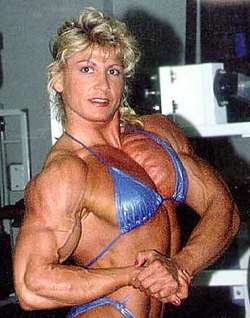
The first U.S. Women's National Physique Championship, promoted by Henry McGhee and held in Canton, Ohio in 1978, is generally regarded as the first true female bodybuilding contest—that is, the first contest where the entrants were judged solely on muscularity.[13] In 1980, the first Ms. Olympia (initially known as the "Miss" Olympia), the most prestigious contest for professionals, was held. The first winner was Rachel McLish, who had also won the NPC's USA Championship earlier in the year. The contest was a major turning point for female bodybuilding. McLish inspired many future competitors to start training and competing. In 1985, a movie called Pumping Iron II: The Women was released. It documented the preparation of several women for the 1983 Caesars Palace World Cup Championship. Competitors prominently featured in the film were Kris Alexander, Lori Bowen, Lydia Cheng, Carla Dunlap, Bev Francis, and McLish. At the time, Francis was actually a powerlifter, though she soon made a successful transition to bodybuilding, becoming one of the leading competitors of the late 1980s and early 1990s.
In recent years, the related areas of fitness and figure competition have increased in popularity, surpassing that of female bodybuilding, and have provided an alternative for women who choose not to develop the level of muscularity necessary for bodybuilding. McLish would closely resemble what is thought of today as a fitness and figure competitor, instead of what is now considered a female bodybuilder. Fitness competitions also have a gymnastic element to them. A study by the Clinical Journal of Sport Medicine found that female bodybuilders who are taking anabolic steroids are more likely to have qualified for substance dependence disorder and have been diagnosed with a psychiatric illness and have a history of sexual abuse.[14]
E Wilma Conner competed in the 2011 NPC Armbrust Pro Gym Warrior Classic Championships in Loveland, Colorado, at the age of 75 years and 349 days.[15]
Competition
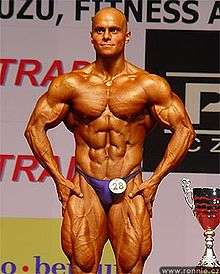
In competitive bodybuilding, bodybuilders aspire to develop and maintain an aesthetically pleasing body and balanced physique.[16][17] In prejudging, competitors do a series of mandatory poses: the front lat spread, rear lat spread, front double biceps, back double biceps, side chest, side triceps, Most Muscular (men only), and the thigh abdominal. Each competitor also performs a routine to display their physique. A posedown is usually held at the end of a posing round, while judges are finishing their scoring. Bodybuilders spend a lot of time practising their posing in mirrors.
In contrast to strongman or powerlifting competitions, where physical strength is important, or to Olympic weightlifting, where the main point is equally split between strength and technique, bodybuilding competitions typically emphasize condition, size, and symmetry. Different organizations emphasize particular aspects of competition, and sometimes have different categories in which to compete.
Preparations
Cutting and bulking
The general strategy adopted by most present-day competitive bodybuilders is to make muscle gains for most of the year (known as the "off-season") and, approximately 12–14 weeks from competition, attempt to lose body fat (referred to as "cutting"). The bulking phase entails remaining in a net positive energy balance (calorie surplus). The amount of a surplus in which a person remains is based on the person's goals, as a bigger surplus and longer bulking phase will create more fat tissue. The surplus of calories relative to one's energy balance will ensure that muscles remain in a state of growth.
The cutting phase entails remaining in a net negative energy balance (calorie deficit). The main goal of cutting is to oxidize fat while preserving as much muscle as possible. The larger the calorie deficit, the faster one will lose weight. However, a large calorie deficit will also create the risk of losing muscle tissue.[18]
The bulking and cutting strategy is effective because there is a well-established link between muscle hypertrophy and being in a state of positive energy balance [19]. A sustained period of caloric surplus will allow the athlete to gain more fat-free mass than they could otherwise gain under eucaloric conditions. Some gain in fat mass is expected, which athletes seek to oxidize in a cutting period while maintaining as much fat-free mass as possible.
Clean bulking
Many non-competitive bodybuilders choose not to adopt the conventional strategy, as it often results in significant unwanted fat gain during the "bulking" phase. The attempt to increase muscle mass in one's body without any gain in fat is called clean bulking. Competitive bodybuilders focus their efforts to achieve a peak appearance during a brief "competition season". Clean bulking takes longer and is a more refined approach to achieving the body fat and muscle mass percentage a person is looking for. A common tactic for keeping fat low and muscle mass high would be to have higher calorie and lower calorie days to maintain a balance between gain and loss. Many clean bulk diets start off with a moderate amount of carbs, moderate amount of protein, and a decently low amount of fats, "Gaining lean muscle means going for leaner cuts of meat, like flank steaks and fillets, chicken, and, of course, fish," says White. "Enjoy your meat with some starch: rice, beans, quinoa, whole-grain couscous, or sweet potato, for example".[20] To maintain a clean bulk it is important to reach calorie goals every day. Macronutrient goals will be different for each person, but, it is ideal to get as close as possible.
Dirty bulking
"Dirty bulking" is the process of eating at a caloric surplus, without finding the exact number of macronutrients (carbs, fats, and proteins). Weightlifters who are attempting to gain mass quickly often choose to use the "dirty bulk" method.[21]
Pre-competition
In the week leading up to a contest, bodybuilders may decrease their consumption of water, sodium, and carbohydrates, the former two to alter how water is retained by the body and the latter to reduce glycogen in the muscle. The day before the show, water is removed from the diet, and diuretics may be introduced, while carbohydrate loading is undertaken to increase the size of the muscles through replenishment of their glycogen. The goal is to maximize leanness and increase the visibility of veins, or "vascularity". The appearance of veins is further enhanced immediately before appearing on stage by darkening the skin through tanning products and applying oils to the skin to increase shine. Some competitors will eat sugar-rich foods to increase the visibility of their veins. A final step is the use of weights to fill the muscles with blood and further increase their size.
Muscle growth
Bodybuilders use three main strategies to maximize muscle hypertrophy:
- Strength training through weights or elastic/hydraulic resistance.
- Specialized nutrition, incorporating extra protein and supplements when necessary.
- Adequate rest, including sleep and recuperation between workouts.
Bodybuilders often shorten these three steps into the well-known motto "eat clean, train hard, sleep well".
Weight training
Weight training causes micro-tears to the muscles being trained; this is generally known as microtrauma. These micro-tears in the muscle contribute to the soreness felt after exercise, called delayed onset muscle soreness (DOMS). It is to repair this micro-trauma that result in muscle growth. Normally, this soreness becomes most apparent a day or two after a workout. However, as muscles become adapted to the exercises, soreness tends to decrease.[22]
Weight training aims to build muscle by prompting two different types of hypertrophy: sarcoplasmic and myofibrillar. Sarcoplasmic hypertrophy leads to larger muscles and so is favored by bodybuilders more than myofibrillar hypertrophy, which builds athletic strength. Sarcoplasmic hypertrophy is triggered by increasing repetitions, whereas myofibrillar hypertrophy is triggered by lifting heavier weight.[23] In either case, there is an increase in size and strength of the muscles (compared to if that same individual does not lift weights at all). However, the emphasis is different.
Many trainees like to cycle between the two methods in order to prevent the body from adapting (maintaining a progressive overload), possibly emphasizing whichever method more suits their goals. i.e. a bodybuilder will use sarcoplasmic hypertrophy most of the time but may change to myofibrillar hypertrophy temporarily in order to move past a plateau. However, no real evidence has been provided to show that trainees ever reach this plateau, and rather was more of a hype created from "muscular confusion".
Nutrition
The high levels of muscle growth and repair achieved by bodybuilders require a specialized diet. Generally speaking, bodybuilders require more calories than the average person of the same weight to provide the protein and energy requirements needed to support their training and increase muscle mass. A sub-maintenance level of food energy is combined with cardiovascular exercise to lose body fat in preparation for a contest. The ratios of calories from carbohydrates, proteins, and fats vary depending on the goals of the bodybuilder.[24]
Carbohydrates
Carbohydrates play an important role for bodybuilders. They give the body energy to deal with the rigors of training and recovery. Carbohydrates also promote secretion of insulin, a hormone enabling cells to get the glucose they need. Insulin also carries amino acids into cells and promotes protein synthesis.[25] Insulin has steroid-like effects in terms of muscle gains. It is impossible to promote protein synthesis without the existence of insulin, which means that without ingesting carbohydrates or protein—which also induces the release of insulin—it is impossible to add muscle mass.[26] Bodybuilders seek out low-glycemic polysaccharides and other slowly digesting carbohydrates, which release energy in a more stable fashion than high-glycemic sugars and starches. This is important as high-glycemic carbohydrates cause a sharp insulin response, which places the body in a state where it is likely to store additional food energy as fat. However, bodybuilders frequently do ingest some quickly digesting sugars (often in form of pure dextrose or maltodextrin) after a workout. This may help to replenish glycogen stored within the muscle, and to stimulate muscle protein synthesis.[27]
Protein
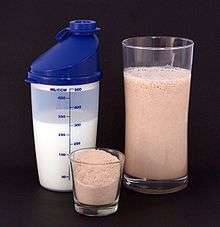
The motor proteins actin and myosin generate the forces exerted by contracting muscles. Current advice says that bodybuilders should consume 25–30% of protein per total calorie intake to further their goal of maintaining and improving their body composition.[28] This is a widely debated topic, with many arguing that 1 gram of protein per pound of body weight per day is ideal, some suggesting that less is sufficient, while others recommending 1.5, 2, or more.[29] It is believed that protein needs to be consumed frequently throughout the day, especially during/after a workout, and before sleep.[30] There is also some debate concerning the best type of protein to take. Chicken, turkey, beef, pork, fish, eggs and dairy foods are high in protein, as are some nuts, seeds, beans, and lentils. Casein or whey are often used to supplement the diet with additional protein. Whey protein is the type of protein contained in many popular brands of protein supplements and is preferred by many bodybuilders because of its high Biological Value (BV) and quick absorption rates. However, whey has a bigger effect than Casein on insulin levels. Whey triggers about double the amount of insulin release.[31] That effect is somewhat overcome by combining Casein and whey. Bodybuilders are usually thought to require protein with a higher BV than that of soy, which is additionally avoided due to its claimed estrogenic properties. Still, some nutrition experts believe that soy, flax seeds and many other plants that contain the weak estrogen-like compounds or phytoestrogens can be used beneficially, as phytoestrogens compete with estrogens for receptor sites in the male body and can block its actions. This can also include some inhibition of pituitary functions while stimulating the P450 system (the system that eliminates hormones, drugs and metabolic waste product from the body) in the liver to more actively process and excrete excess estrogen.[32][33] Cortisol decreases amino acid uptake by muscle, and inhibits protein synthesis.[34]
Contrary to certain rumors that animal-based protein is more suitable to trigger muscle growth than plant-based protein, a study by Mangano et al. (2017) could not provide any evidence for this. In contrast, if combined properly plant-based protein even has a higher biological quality. A combination of one part wheat protein (e.g. seitan) and two parts soy protein (e.g. tofu) has thus been favored by many bodybuilders. Some bodybuilders, such as Patrik Baboumian and Robert Cheeke, follow a strict vegan diet.[35]
Meals
Bodybuilders often split their food intake for the day into 5 to 7 meals of roughly equal nutritional content and attempt to eat at regular intervals (e.g. every 2 to 3 hours). This method can serve two purposes: to limit overindulging in the cutting phase, and to physically allow for the consumption of large volumes of food during the bulking phase. Contrary to popular belief, eating more frequently does not increase basal metabolic rate when compared to the traditional 3 meals a day. While food does have a metabolic cost to digest, absorb, and store, called the thermic effect of food, it depends on the quantity and type of food, not how the food is spread across the meals of the day. Well-controlled studies using whole-body calorimetry and doubly labeled water have demonstrated that there is no metabolic advantage to eating more frequently.[36][37][38]
Dietary supplements
The important role of nutrition in building muscle and losing fat means bodybuilders may consume a wide variety of dietary supplements.[39] Various products are used in an attempt to augment muscle size, increase the rate of fat loss, improve joint health, increase natural testosterone production, enhance training performance and prevent potential nutrient deficiencies. There are three major macronutrients that the human body needs in order for muscle building. The major nutrients – protein, carbohydrate, and fat – provide the body with energy.[40]
Performance-enhancing substances
Some bodybuilders use drugs such as anabolic steroids and precursor substances such as prohormones to increase muscle hypertrophy. Anabolic steroids cause muscle hypertrophy of both types (I and II) of muscle fibers caused likely by an increased synthesis of muscle proteins and are accompanied with undesired side effects including hepatotoxicity, gynecomastia, acne, the early onset of male pattern baldness and a decline in the body's own testosterone production, which can cause testicular atrophy.[41][42][43] Other performance-enhancing substances used by competitive bodybuilders include human growth hormone (HGH), which can cause acromegaly.
Muscle growth is more difficult to achieve in older adults than younger adults because of biological aging, which leads to many metabolic changes detrimental to muscle growth; for instance, by diminishing growth hormone and testosterone. Some recent clinical studies have shown that low-dose HGH treatment for adults with HGH deficiency changes the body composition by increasing muscle mass, decreasing fat mass, increasing bone density and muscle strength, improves cardiovascular parameters, and affects the quality of life without significant side effects.[44][45][46]
A recent trend in bodybuilding is to inject synthol[47] into muscles to create larger bulges, or injecting PMMA into muscles to shape them. Use of PMMA to shape muscles is prohibited in the United States.[48]
Rest
Although muscle stimulation occurs in the gym (or home gym) when lifting weights, muscle growth occurs afterward during rest. Without adequate rest and sleep (6 to 8 hours), muscles do not have an opportunity to recover and build. About eight hours of sleep a night is desirable for the bodybuilder to be refreshed, although this varies from person to person.[49] Additionally, many athletes find a daytime nap further increases their body's ability to build muscles. Some individual bodybuilders add a massage, sometimes by professional masseuse, massager or masseur at the end of each workout to their routine as a method of recovering.[50]
Overtraining
Overtraining occurs when a bodybuilder has trained to the point where his workload exceeds his recovery capacity. There are many reasons that overtraining occurs, including lack of adequate nutrition, lack of recovery time between workouts, insufficient sleep, and training at a high intensity for too long (a lack of splitting apart workouts). Training at a high intensity too frequently also stimulates the central nervous system (CNS) and can result in a hyperadrenergic state that interferes with sleep patterns.[51] To avoid overtraining, intense frequent training must be met with at least an equal amount of purposeful recovery. Timely provision of carbohydrates, proteins, and various micronutrients such as vitamins, minerals, phytochemicals, even nutritional supplements are acutely critical. A mental disorder known as bigorexia may be held accountable of some people overtraining. Sufferers feel as if they are never big enough or muscular enough. Therefore, this forces them to overtrain in order to try and reach this goal physique.[52]
It has been argued that overtraining can be beneficial. One article published by Muscle & Fitness magazine stated that you can "Overtrain for Big Gains". It suggested that if one is planning a restful holiday and they do not wish to inhibit their bodybuilding lifestyle too much, they should overtrain before taking the holiday, so the body can rest easily and recuperate and grow. Overtraining can be used advantageously, as when a bodybuilder is purposely overtrained for a brief period of time to super compensate during a regeneration phase. These are known as "shock micro-cycles" and were a key training technique used by Soviet athletes.[53]
Injecting oil into muscles
Site enhancement oil, often called "santol" or "synthol" (no relation to the Synthol mouthwash brand), refers to oils injected into muscles to increase the size or change the shape. Some bodybuilders, particularly at the professional level, inject their muscles with such mixtures to mimic the appearance of developed muscle where it may otherwise be disproportionate or lagging.[54] This is known as "fluffing".[55][56] Synthol is 85% oil, 7.5% lidocaine, and 7.5% alcohol.[55] It is not restricted, and many brands are available on the Internet.[57] The use of injected oil to enhance muscle appearance is common among bodybuilders,[58][59] despite the fact that synthol can cause pulmonary embolisms, nerve damage, infections, sclerosing lipogranuloma,[60] stroke,[55] and the formation of oil-filled granulomas, cysts or ulcers in the muscle.[59][61][62] Rare cases might require surgical intervention to avoid further damage to the muscle and/or to prevent loss of life.[63]
Sesame oil is often used in such mixtures, which can cause allergic reactions such as vasculitis.[64]
As the injected muscle is not actually well-developed, it might droop under gravity.[57]
See also
References
- ↑ Emery, Michael. "Men's Bodybuilding: A Short History". Bodybuildingreviews.net. Retrieved February 25, 2014.
- ↑ Karthikeyan, D. (January 12, 2013). "Locked horns and a flurry of feathers" – via www.thehindu.com.
- ↑ Schwarzenegger, A. (1999). The New Encyclopedia of Modern Bodybuilding. Fireside, NY: Simon & Schuster. ISBN 0684857219.
- ↑ Rhodes, Jesse (July 19, 2009). "Bodybuilders Through the Ages".
- ↑ "Al Treloar at SandowPlus.com". Sandowplus.co.uk. December 28, 1903. Archived from the original on June 29, 2012. Retrieved October 5, 2012.
- ↑ STRONGFORTISM Archived August 2, 2008, at the Wayback Machine.
- ↑ "IFBB Professional League - Jim Manion, Chairman IFBB Professional League". Ifbbpro.com. September 26, 2007. Archived from the original on September 21, 2012. Retrieved October 5, 2012.
- ↑ "Arnold: No Regrets About Steroids". CBS. February 11, 2009. Retrieved August 13, 2013.
- ↑ Theunissen, Steve. "Arnold & Steroids: Truth Revealed". Archived from the original on October 8, 2003. Retrieved February 27, 2007.
- ↑ Controlled Drugs and Substances Act, SC 1996, c. 19, Schedule IV, no. 23.
- ↑ Littman, Jean (November 13, 2007). "Bodybuilding And The Olympics: An Ongoing Controversy". article99.com. Archived from the original on December 5, 2007.
- ↑ Ifbb Faq – Ifbb. Ifbb.com (February 22, 1999). Retrieved on 2016-11-29.
- ↑ Todd, Jan, "Bodybuilding", St. James Encyclopedia of Pop Culture, Gale Group, 1999
- ↑ Barnett, Mitchell (Nov 2010). "Women and Anabolic Steroids: An Analysis of a Dozen Users". Clinical Journal of Sport Medicine. 20 (6): 475–81. doi:10.1097/JSM.0b013e3181fb5370. PMID 21079445.
- ↑ Glenday, Craig (2013). Guinness World Records 2014. The Jim Pattison Group. p. 60. ISBN 978-1-908843-15-9.
- ↑ "Top 10 Most Impressive Bodybuilder Physiques of All Time". Muscleprodigy. Retrieved June 14, 2013.
- ↑ "Judging the 2008 Mr. Olympia: Judges Provide Full Transparency and Complete Explanation of Results". Muscletime. Retrieved June 14, 2013.
- ↑ Lambert, Charles; Frank L; Evens W (March 2004). "Macronutrient considerations for the sport of bodybuilding". Sports Med. 34 (5): 317–27. doi:10.2165/00007256-200434050-00004. PMID 15107010.
- ↑ the science and development of muscle hypertrophy, Dr. Brad Schoenfeld, page 139-140
- ↑ Giblin, Chris. "Clean Bulking: for Frustrated Hard-Gainers, Clean Bulking Is Attainable If You Focus Your Diet Accordingly with the Right Foods and Strategy." Joe Weider's Muscle & Fitness, vol. 75, no. 8, 2014, p. 89.
- ↑ Evans, Rian. (April 6, 2015) Dirty Bulking: Why You Need To Know The Dirty Truth!. Bodybuilding.com. Retrieved on 2016-11-29.
- ↑ MacDougall JD, Elder GC, Sale DG, Moroz JR, Sutton JR (1980). "Effects of strength training and immobilization on human muscle fibres". European journal of applied physiology and occupational physiology. 43 (1): 25–34. doi:10.1007/BF00421352. PMID 7371625.
- ↑ "Weight Training Intensity or Volume for Bigger Muscles?". Retrieved February 24, 2012.
- ↑ Manoreem, MM; Thompson J; Russo M (March 1993). "Diet and exercise strategies of a world-class bodybuilder". Int J Sport Nutr. Dept. of Family Resources & Human Development, Arizona State University. 3 (1): 76–86. PMID 8499940.
- ↑ Skinner, Rob (March 2002). "Coach & Athletic Director". 71 (8): 3.
- ↑ Miranda, Lisa; Horman, Sandrine; De Potter, Isabelle; Hue, Louis; Jensen, Jørgen; Rider, Mark H. (2007). "Effects of contraction and insulin on protein synthesis, AMP-activated protein kinase and phosphorylation state of translation factors in rat skeletal muscle". Pflügers Archiv. 455 (6): 1129–40. doi:10.1007/s00424-007-0368-2. PMID 17957382.
- ↑ King, Michael W. "Substrates for Gluconeogenesis". IU School of Medicine.
- ↑ Lambert CP, Frank LL, Evans WJ (2004). "Macronutrient considerations for the sport of bodybuilding". Sports Med. 34 (5): 317–27. doi:10.2165/00007256-200434050-00004. PMID 15107010.
- ↑ Heller, Samantha (April 2004) Protein: a guide to maximum muscle: confused? Let us separate the gristle from the meat, Men's Fitness,
- ↑ "Your nutrition problems solved; This month: pre- and postworkout nutrition, calculating protein intake and adding simple carbs". FLEX Magazine, January 2005
- ↑ Burd, Nicholas A.; Yang, Yifan; Moore, Daniel R.; Tang, Jason E.; Tarnopolsky, Mark A.; Phillips, Stuart M. (2012). "Greater stimulation of myofibrillar protein synthesis with ingestion of whey protein isolate v. Micellar casein at rest and after resistance exercise in elderly men". British Journal of Nutrition. 108 (6): 958–62. doi:10.1017/S0007114511006271. PMID 22289570.
- ↑ Falcon, Mike. Estrogens, Testosterone & Phytoestrogens. maxmuscle.com
- ↑ Eugene Shippen; William Fryer (1998). The testosterone syndrome: the critical factor for energy, health, and sexuality: reversing the male menopause. New York: M. Evans. ISBN 0-87131-829-6.
- ↑ Manchester, K. L. (2012). "Sites of Hormonal Regulation of Protein Metabolism". In Munro, H. N. Mammalian Protein Metabolism, Volume 4. pp. 229–98. ISBN 978-0-323-14257-1.
- ↑ Mangano, Kelsey M.; Sahni, Shivani; Kiel, Douglas P.; Tucker, Katherine L.; Dufour, Alyssa B.; Hannan, Marian T. (February 8, 2017). "Dietary protein is associated with musculoskeletal health independently of dietary pattern: the Framingham Third Generation Study". The American Journal of Clinical Nutrition. 105: ajcn136762. doi:10.3945/ajcn.116.136762. PMC 5320406. PMID 28179224 – via ajcn.nutrition.org.
- ↑ Bellisle F, McDevitt R, Prentice AM (1997). "Meal frequency and energy balance". Br. J. Nutr. 77 Suppl 1: S57–70. doi:10.1079/BJN19970104. PMID 9155494.
- ↑ Taylor MA, Garrow JS (2001). "Compared with nibbling, neither gorging nor a morning fast affect short-term energy balance in obese patients in a chamber calorimeter". Int. J. Obes. Relat. Metab. Disord. 25 (4): 519–28. doi:10.1038/sj.ijo.0801572. PMID 11319656.
- ↑ Smeets AJ, Westerterp-Plantenga MS (June 2008). "Acute effects on metabolism and appetite profile of one meal difference in the lower range of meal frequency". Br. J. Nutr. 99 (6): 1316–21. doi:10.1017/S0007114507877646. PMID 18053311.
- ↑ Philen RM, Ortiz DI, Auerbach SB, Falk H (1992). "Survey of advertising for nutritional supplements in health and bodybuilding magazines". JAMA. 268 (8): 1008–11. doi:10.1001/jama.268.8.1008. PMID 1501305.
- ↑ "Major Nutrients in Food". webMd. Retrieved August 27, 2013.
- ↑ Schroeder E, Vallejo A, Zheng L, et al. (2005). "Six-week improvements in muscle mass and strength during androgen therapy in older men". J Gerontol a Biol Sci Med Sci. 60 (12): 1586–92. doi:10.1093/gerona/60.12.1586. PMID 16424293.
- ↑ Grunfeld C, Kotler D, Dobs A, Glesby M, Bhasin S (2006). "Oxandrolone in the treatment of HIV-associated weight loss in men: a randomized, double-blind, placebo-controlled study". J Acquir Immune Defic Syndr. 41 (3): 304–14. doi:10.1097/01.qai.0000197546.56131.40. PMID 16540931.
- ↑ Giorgi A, Weatherby R, Murphy P (1999). "Muscular strength, body composition and health responses to the use of testosterone enanthate: a double blind study". Journal of science and medicine in sport / Sports Medicine Australia. 2 (4): 341–55. doi:10.1016/S1440-2440(99)80007-3. PMID 10710012.
- ↑ Alexopoulou O, Abs R, Maiter D (2010). "Treatment of adult growth hormone deficiency: who, why and how? A review". Acta Clinica Belgica. 65 (1): 13–22. doi:10.1179/acb.2010.002. PMID 20373593.
- ↑ Ahmad AM, Hopkins MT, Thomas J, Ibrahim H, Fraser WD, Vora JP (June 2001). "Body composition and quality of life in adults with growth hormone deficiency; effects of low-dose growth hormone replacement". Clinical Endocrinology. 54 (6): 709–17. doi:10.1046/j.1365-2265.2001.01275.x. PMID 11422104.
- ↑ Savine R, Sönksen P (2000). "Growth hormone – hormone replacement for the somatopause?". Hormone Research. 53 (Suppl 3): 37–41. doi:10.1159/000023531. PMID 10971102.
- ↑ Pupka, Artur; Sikora, Julita; Mauricz, Jakub; Cios, Dariusz; Płonek, Tomasz (2009). "Stosowanie Syntholu w kulturystyce" [The usage of the Synthol in the body building]. Polimery w medycynie (in Polish). 39 (1): 63–5. PMID 19580174.
- ↑ http://internationalsurgery.com/pmma-injections-and-bodybuilding/ Retrieved June 22, 2017.
- ↑ Datillo M, Antunes HK, Meideros A, et al. (2011). "Sleep and muscle recovery: Endocrinological and molecular basis for a new and promising hypothesis". Medical Hypotheses. 77 (2): 220–22. doi:10.1016/j.mehy.2011.04.017. PMID 21550729.
- ↑ Shusterman, Richard (2012). Thinking Through the Body: Essays in Somaesthetics. Cambridge University. p. 43. ISBN 1107019060.
- ↑ Lowery, Lonnie. Testosterone Nation – The Warrior Nerd: Overtraining or Under-eating? Part 1
- ↑ Mosley, Philip E. (2009-05-01). "Bigorexia: bodybuilding and muscle dysmorphia". European Eating Disorders Review. 17 (3): 191–198. doi:10.1002/erv.897. ISSN 1099-0968.
- ↑ Smith DJ (2003). "A framework for understanding the training process leading to elite performance". Sports Medicine. 33 (15): 1103–26. doi:10.2165/00007256-200333150-00003. PMID 14719980.
- ↑ Jason, P (March 31, 2015). "Synthol Abuse in Bodybuilding". ProteinFart.com. Archived from the original on January 20, 2016.
- 1 2 3 Pupka, A; Sikora J; Mauricz J; Cios D; Płonek T. (2009). "The usage of synthol in the body building". Polim Med. (in Polish). 39 (1): 63–5. PMID 19580174.
- ↑ Childs, Dan (May 16, 2007). "Like Implants for the Arms: Synthol Lures Bodybuilders: Risky Injections Mean Massive Muscles for Users". ABC News. Retrieved March 4, 2011.
- 1 2 Foggo, Daniel (May 13, 2007). "Bodybuilders puff up with 'Popeye the Sailorman' oil jab". Sunday Times. Archived from the original on May 24, 2011. Retrieved March 4, 2011.
- ↑ Henriksen, TF; Løvenwald JB; Matzen SH (2010). "Paraffin oil injection in bodybuilders calls for preventive action". Ugeskrift for Lægerer (in Danish). 172 (3): 219–20. PMID 20089216.
- 1 2 Iversen, Line; Asja Lemcke; Mikael Bitsch; Tonny Karlsmark (2008). "Compression Bandage as Treatment for Ulcers Induced by Intramuscular Self-injection of Paraffin Oil". Acta Derm Venereol. 89 (2): 196doi=10.2340/00015555-0583.
- ↑ Schaefer, N (2011). "Muscle enhancement using intramuscular injections of oil in bodybuilding: review on epidemiology, complications, clinical evaluation and treatment". European Surgery. 44: 109–115. doi:10.1007/s10353-011-0033-z.
- ↑ Darsow, Ulf; Harald Bruckbauer; Wolf-Ingo Worret; Heidelore Hofmann; Johannes Ring (2000). "Subcutaneous oleomas induced by self-injection of sesame seed oil for muscle augmentation". Journal of the American Academy of Dermatology. 42 (2): 292–294. doi:10.1016/S0190-9622(00)90144-0. PMID 10642691.
- ↑ Schäfer, C.N.; H. Guldager; H. L. Jørgensen (2011). "Multi-Organ Dysfunction in Bodybuilding Possibly Caused by Prolonged Hypercalcemia due to Multi-Substance Abuse: Case Report and Review of Literature". Int J Sports Med. 32 (1): 60–65. doi:10.1055/s-0030-1267200. PMID 21072745.
- ↑ Grenoble, Ryan (2015-05-05). "Guy Who Wanted To Be A Real-Life Hulk Almost Had To Have Arms Amputated". Huffington Post. Retrieved 2017-12-01.
- ↑ Koopman, M; C. Richter; R. J. M. Parren; M. Janssen (2005). "Bodybuilding, sesame oil and vasculitis". Rheumatology. Oxford Journals. 44 (9): 1135. doi:10.1093/rheumatology/keh712. PMID 16113147.
External links
| For a list of words relating to used in bodybuilding, see the Bodybuilding category of words in Wiktionary, the free dictionary. |
| Wikibooks has more on the topic of: Bodybuilding |
| Wikimedia Commons has media related to Bodybuilding. |